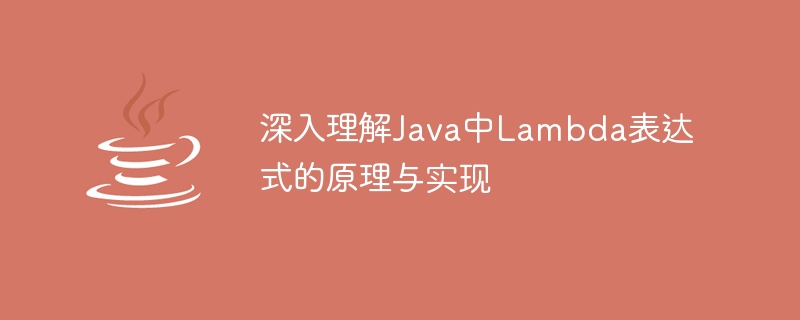Home >Java >javaTutorial >In-depth exploration of the mechanism and implementation of Lambda expressions in Java
In-depth exploration of the mechanism and implementation of Lambda expressions in Java
- PHPzOriginal
- 2024-01-30 08:03:061090browse

In-depth understanding of the principles and implementation of Lambda expressions in Java requires specific code examples
Introduction:
With the release of Java 8, Lambda expressions have become One of the highlights of the Java language. Lambda expressions can make code more concise and readable, and better support functional programming. However, the principle and implementation of Lambda expressions are not that simple. This article will deeply explore the principles and implementation mechanisms of Lambda expressions in Java, and deepen understanding through specific code examples.
1. The principle of Lambda expression
Lambda expression is a functional programming feature introduced in the Java language. It can create an anonymous implementation of a functional interface and pass it as a parameter to a method, or return it directly as a return value.
In Java, the implementation of Lambda expressions is based on the concept of "functional interface". Functional interface refers to an interface that contains only one abstract method. Lambda expressions can infer and create an instance of a functional interface from the type of the functional interface.
In Lambda expressions, the arrow "->" acts as a connector. The left side of the arrow is the parameter list, and the right side of the arrow is the body of the Lambda expression.
2. Implementation of Lambda expressions
The implementation of Lambda expressions relies on two new features in Java: "Method Handle" and "Invoke Dynamic".
"Method Handle" is a mechanism in Java to support dynamic method invocation. It can bypass the virtual machine's process of finding methods and call methods directly. In a Lambda expression, the body of the Lambda expression can be implemented through "Method Handle".
"Invoke Dynamic" is a new bytecode instruction provided in Java. It can bind method calls to actual execution, avoiding the restriction of determining class information at compile time. In a Lambda expression, the parameter list and return value type of the Lambda expression can be determined through "Invoke Dynamic".
The following is a specific code example to demonstrate the implementation process of Lambda expression:
public class LambdaDemo {
public static void main(String[] args) {
MyInterface myInterface = (a, b) -> a + b;
System.out.println(myInterface.add(3, 5));
}
interface MyInterface {
int add(int a, int b);
}
}In the above code, we define a functional interface MyInterface, It contains an abstract method add. We then used Lambda expressions to create an anonymous implementation of MyInterface.
Lambda expression(a, b) -> a b represents an anonymous method with two parameters. Its function is to add the two parameters and return the result.
In the main method, we assign the Lambda expression to myInterface through MyInterface myInterface = (a, b) -> a b; variable. Then we call myInterface.add(3, 5) to execute the Lambda expression and output the result to the console.
The above is a basic introduction to the principle and implementation mechanism of Lambda expressions. Through code examples, we can better understand the core ideas and mechanisms of Lambda expressions.
Conclusion:
Lambda expression in Java is a feature of functional programming, which can create an anonymous implementation through a functional interface. The implementation of Lambda expressions relies on the two features of "Method Handle" and "Invoke Dynamic" in Java. By deeply understanding the principles and implementation of Lambda expressions, we can better apply it to improve the simplicity and readability of the code.
The above is the detailed content of In-depth exploration of the mechanism and implementation of Lambda expressions in Java. For more information, please follow other related articles on the PHP Chinese website!

